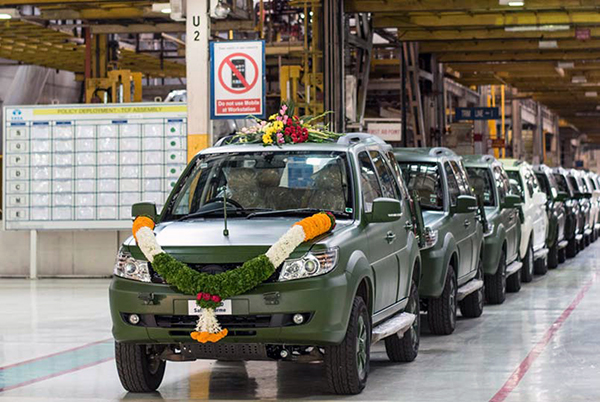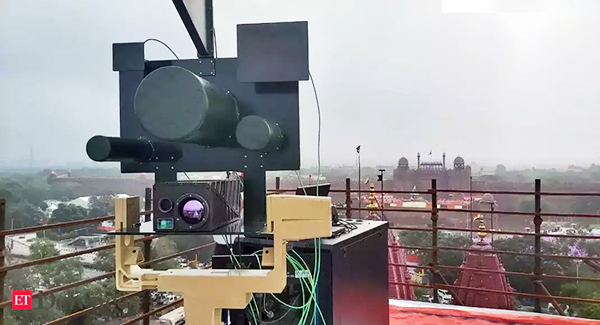
Tata Motors Rolls-Out Its 1500th Safari Storme
Tata Motors announced, on 25 August, the roll-out of its 1500th GS800 (General Service 800) Safari Storme SUVs specially made for the Indian Armed Forces. The milestone GS800 Safari Storme was rolled out of the company’s manufacturing plant in Pune, Maharashtra, and is part of the 3192 vehicles that the company is supplying to the Indian Army. So far, Tata Motors has already delivered over 1300 units of the 4×4 SUVs, and with the addition of the recent lot, we believe the company will soon complete 50 per cent of its delivery target.
Commenting on the successful roll-out of the 1500th Tata GS800 Safari Storme, Vernon Noronha, Vice President, Defence & Government Business, Tata Motors Limited said, “We, at Tata Motors, take immense pride to roll-out the 1500th GS800 Safari Storme of the 3192 order for the Indian Army. This modern SUV – Tata GS800 is specially customized to meet the requirements of the Indian Armed Forces. The continued faith bestowed by the country’s security forces in Tata Motors is a reflection of our pedigree & aspiration to serve the nations challenging requirements on the front lines.”
Cobham to Buy UK Rival Ultra in $3.6 bn Deal
Defence firm Cobham said, on 16 August, that it had agreed to buy Ultra Electronics in a deal valuing its UK-listed rival at 2.57 billion pounds ($3.56 billion), setting out commitments aimed at allaying any potential concerns over national security.
Cobham, which was taken private by U.S. private equity firm Advent last year, said it will safeguard and support the UK’s national security and create new manufacturing and engineering jobs and apprenticeships. It will also protect existing jobs, maintain a UK headquarters and boost investment.
In order to protect Ultra’s businesses and stakeholders, Cobham said it will engage with the British government to agree details of its binding commitments – including their duration and form.
The deal will help Cobham tap the maritime defence market, where Ultra sells sensors and torpedo and radar systems, mainly to Western customers. Ultra also makes a range of defence communication equipment and forensics software.
BrahMos Missile Production Centre to be Set Up in UP
The Uttar Pradesh government, on 24 August, said the “next generation state of the art” BrahMos missiles will be manufactured in the state with the BrahMos Aerospace company planning to set up a plant in the Defence Industrial Corridor.
BrahMos Aerospace had sought 200 acres of land for the project in the Defence Corridor for setting up its BrahMos missile plant. About 500 engineers and technical people will get direct employment in the BrahMos production centre, which will be built by investing Rs 300 crore on the land to be allotted at Lucknow node. About 5,000 people will get indirect employment and 10,000 people will get work through the production centre.
“Research and development work will also be done in these centres. More than 100 BrahMos missiles are planned to be built in the next three years. Due to the BrahMos production centre, many other well-known companies working in the defence sector in the UP Defence Corridor will come to the state,” a statement issued by the government said.
Army Wants Additional Akash Batteries and Dhruv Helos
The Indian Army has sent proposals worth around Rs 14,000 crore to acquire two regiments of the Akash-S air defence missile system and 25 Advanced Light Helicopters (ALHs).
The proposal is with the Defence Ministry and a decision on the approval is expected soon at a high-level meeting to be chaired by Defence Minister Rajnath Singh.
The Akash-S missiles are a new variant of the Akash missile system with a new indigenous seeker which helps in improving the accuracy in taking down enemy aircraft and cruise missiles at distances up to 25-30 kms, they said.
The missiles are capable of performing in extreme cold weather conditions in Ladakh and would meet all the requirements of the Indian Army in mountainous and other regions along the boundaries with China and Pakistan.
The DRDO has also recently tested the Akash-New Generation variant of the Akash missile systems which allows the troops to use it for longer range intersection of enemy targets and capability to operate at very high altitude locations along the Northern Borders.
The Army is also looking at acquiring 25 ALH Dhruv Mark 3 helicopters for its aviation squadrons.
Armed Forces’ Revenue Procurement Powers Expanded
Defence Minister Rajnath Singh, on 7 September, approved the expansion of financial powers to the armed forces for revenue procurement to cut delays in making purchases for operational preparedness and quickly meet requirements of the field formations.
The delegated financial powers of vice chiefs of the services have been increased by 10 percent subject to an overall ceiling of Rs 500 crore.
The primary focus of the enhanced delegation of financial powers is to empower field commanders and other officials to procure equipment and “war-like stores” in a speedy manner for urgent operational necessities and meeting essential sustenance requirements.
A new schedule on the hiring of aircraft and associated equipment has been introduced for the Indian Air Force which includes the hiring of air-to-air refuellers.
The financial powers of Chief of Integrated Defence Staff to the Chairman Chiefs Of Staff Committee (CISC) as CFA has been enhanced substantially and aligned with that of the vice chiefs of the services.
New CFAs have been added namely Deputy Chief of Army Staff, Master General Sustenance, ADG (Procurement)/DG Air Operations/DG Naval Operations, etc in service headquarters and in the field formations on account of reorganisation/ restructuring/ functional requirements.
New financial powers have been introduced for Navy and the Indian Air Force for their field commanders in line with the existing “Army schedule on ‘Army Commanders Special Financial Powers’”.
For the Indian Navy, powers for replenishment of disaster management equipment and materials have been delegated to the command level for immediate response to natural disasters and humanitarian assistance and disaster relief (HADR) operations.
Navy, BEL Ink Contract for Anti-drone System
The Indian Navy, on 31 August, signed a contract with Bharat Electronics Limited (BEL) for India’s first locally made naval anti-drone system (NADS) with both “hard kill” and “soft kill capabilities”, the ministry of defence said in a statement. The deal comes two months after small drones were used to target the Jammu air force station on June 27, the first-ever offensive use of drones to target an Indian military facility.
BEL will sign similar contracts with the army and the Indian Air Force, the statement said.
The anti-drone system will give the military both “soft kill” and “hard kill” options to tackle the new and fast-emerging aerial threat. The first refers to jamming the hostile drone, while the second involves a laser-based kill system. The indigenous anti-drone system has been developed by the DRDO and manufactured by BEL. The DRDO said its counter-drone technology could provide the armed forces with the capability to swiftly detect, intercept and destroy small drones that pose a security threat.
“The NADS can instantly detect and jam micro drones and use a laser-based kill mechanism to terminate targets. It will be an effective, all-encompassing counter to the increased drone threat to strategic naval installations,” the statement said.
The system was deployed for VVIP protection duties during Republic Day 2020, the visit of US President Donald Trump to Motera stadium in Ahmedabad, Independence Day 2020, Republic Day 2021 and Independence Day 2021. DRDO demonstrated its counter-drone technology to different security agencies at the Hindon air force station in January 2020 and at the National Security Guard (NSG) campus in Manesar in August 2020 and January 2021.
Mahindra Defence Systems Bags Contract for ASW Suite
Mahindra and Mahindra Ltd, on 27 August, said its group firm, Mahindra Defence Systems Limited (MDS) had bagged a contract worth ₹1,349.95 crore for manufacturing of Integrated Anti-Submarine Warfare Defence Suite (IADS) for modern warships of Indian Navy.
“IADS is a high-end underwater equipment that uses latest technology. It is designed to detect and protect warships from underwater threats. It is a versatile system capable of operations from all sizes of warships – small, medium, and large. The complex array of sensors in water undertakes surveillance, and provides inputs for signal processing and analysis, to enable necessary action,” the statement said.
Mahindra Defence will be supplying 14 IADS systems for the Indian Navy warships, it added.
“The IADS comes with an integrated capability for detecting enemy submarines and torpedoes at extended ranges as well as diverting incoming torpedoes fired by enemy submarines,” the Ministry said.


















